《病原生物学(医学微生物学)》课程教学课件(英文)02_Bacteria Growth_Survival_Death_01
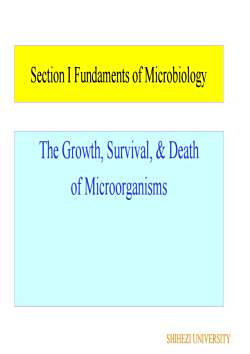
Section IFundaments of MicrobiologyThe Growth, Survival, & Deathof MicroorganismsSHIHEZI UNIVERSITY
Section I Fundaments of Microbiology The Growth, Survival, & Death of Microorganisms SHIHEZI UNIVERSITY
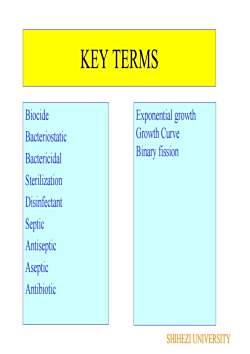
KEY TERMSBiocideExponential growthGrowth CurveBacteriostaticBinary fissionBactericidalSterilizationDisinfectantSepticAntisepticAsepticAntibioticSHIHEZI UNIVERSITY
KEY TERMS Exponential growth Growth Curve Binary fission Biocide Bacteriostatic Bactericidal Sterilization Disinfectant Septic Antiseptic Aseptic Antibiotic SHIHEZI UNIVERSITY
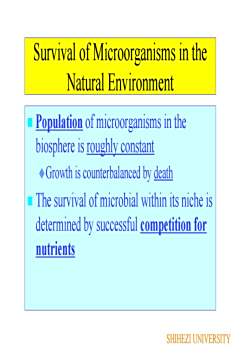
Survival of Microorganisms in theNatural EnvironmentPopulation of microorganisms in thebiosphere is roughly constantGrowth is counterbalanced by death The survival of microbial within its niche isdetermined by successful competition fornutrientsSHIHEZI UNIVERSITY
Survival of Microorganisms in the Natural Environment Population of microorganisms in the biosphere is roughly constant Growth is counterbalanced by death The survival of microbial within its niche is determined by successful competition for nutrients SHIHEZI UNIVERSITY
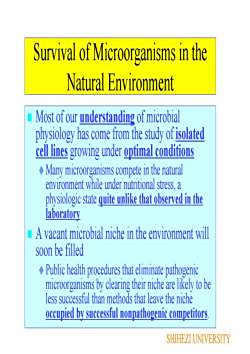
Survival of Microorganisms in theNatural Environment Most of our understanding of microbialphysiology has come from the study of isolatedcell lines growing under optimal conditionsMany microorganisms compete in the naturalenvironment while under nutritional stress, aphysiologic state quite unlike that observed in theiaboratory A vacant microbial niche in the environment willsoon be filled Public health procedures that eliminate pathogenicmicroorganisms by clearing their niche are likely to beess successful than methods that leave the nicheoccupied by successful nonpathogenic competitorsSHIHEZIUNIVERSITY
Survival of Microorganisms in the Natural Environment Most of our understanding of microbial physiology has come from the study of isolated cell lines growing under optimal conditions Many microorganisms compete in the natural environment while under nutritional stress, a physiologic state quite unlike that observed in the laboratory A vacant microbial niche in the environment will soon be filled Public health procedures that eliminate pathogenic microorganisms by clearing their niche are likely to be less successful than methods that leave the niche occupied by successful nonpathogenic competitors. SHIHEZI UNIVERSITY

The Meaning of GrowthGrowth is the orderly increase in the sumof all the components of an organismIncrease in size that results when a cell takesup water or deposits lipid or polysaccharide isnot true growthCell multiplication is a consequence ofgrowthIn unicellular organisms, growth leads to anincrease in the number of individualsSHIHEZI UNIVERSITY
The Meaning of Growth Growth is the orderly increase in the sum of all the components of an organism Increase in size that results when a cell takes up water or deposits lipid or polysaccharide is not true growth Cell multiplication is a consequence of growth In unicellular organisms, growth leads to an increase in the number of individuals SHIHEZI UNIVERSITY
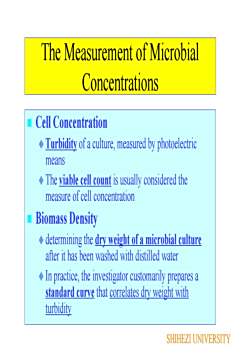
The Measurement of MicrobialConcentrations Cell ConcentrationTurbidity of a culture, measured by photoelectricmeansThe viable cell count is usually considered themeasure of cell concentrationBiomass Density+ determining the dry weight of a microbial cultureafter it has been washed with distilled waterIn practice, the investigator customarily preparesastandard curve that correlates dry weight withturbiditySHIHEZI UNIVERSITY
The Measurement of Microbial Concentrations Cell Concentration Turbidity of a culture, measured by photoelectric means The viable cell count is usually considered the measure of cell concentration Biomass Density determining the dry weight of a microbial culture after it has been washed with distilled water In practice, the investigator customarily prepares a standard curve that correlates dry weight with turbidity SHIHEZI UNIVERSITY
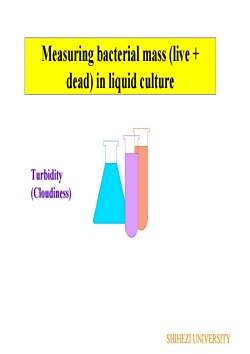
Measuring bacterial masss (live +dead) in ligquid cultureTurbidity(Cloudiness)SHIHEZI UNIVERSITY
Measuring bacterial mass (live + dead) in liquid culture Turbidity Turbidity (Cloudiness) (Cloudiness) SHIHEZI UNIVERSITY
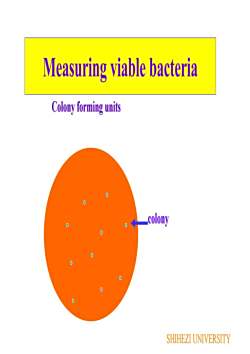
Measuring viable bacteriaColony forming unitscolonySHIHEZI UNIVERSITY
Measuring viable bacteria colony colony Colony forming units Colony forming units SHIHEZI UNIVERSITY
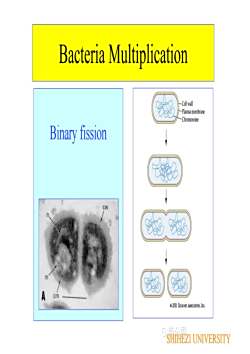
Bacteria MultiplicationCell all-Plasma membraneChromosomeBinary fission2insocia苗刻SHIHEZI UNIVERSITY
Bacteria Multiplication Binary fission G- 菌分 分 裂 SHIHEZI UNIVERSITY
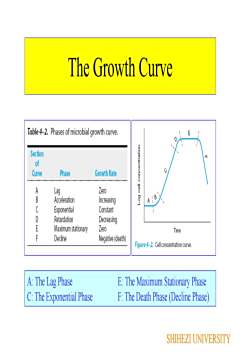
The Growth CurveTable4-2. Phasesof microbial growth curveoieSectionofPhaseCurveGrowthRateZeroALagBBAccelerationIncreasingCExponentialConstantDRetardationDecreasingLLMaximum stationaryZeroTimeLLDeclineNegative death)Figure 4-2. Cell oncentration curve.A: The Lag PhaseE: The Maximum Stationary PhaseC: The Exponential PhaseF: The Death Phase (Decline PhaseSHIHEZI UNIVERSITY
The Growth Curve A: The Lag Phase E: The Maximum Stationary Phase C: The Exponential Phase F: The Death Phase (Decline Phase) SHIHEZI UNIVERSITY
按次数下载不扣除下载券;
注册用户24小时内重复下载只扣除一次;
顺序:VIP每日次数-->可用次数-->下载券;
- 《病原生物学(医学微生物学)》课程教学课件(英文)08_Spore-forming G+ bacilli_Clostridia.pdf
- 《病原生物学(医学微生物学)》课程教学课件(英文)05_Bacteria Genetics.pdf
- 《病原生物学(医学微生物学)》课程教学课件(英文)04_Microbial Metabolism.pdf
- 《病原生物学(医学微生物学)》课程教学课件(英文)06_Bacteria Pathogenesis.pdf
- 《病原生物学(医学微生物学)》课程教学课件(英文)07_Normal microbial flora.pdf
- 《病原生物学(医学微生物学)》课程教学课件(英文)13_Enterobacteriaceae.pdf
- 《病原生物学(医学微生物学)》课程教学课件(英文)12_Nesseria.pdf
- 《病原生物学(医学微生物学)》课程教学课件(英文)10_Staphylococcus.pdf
- 《病原生物学(医学微生物学)》课程教学课件(英文)18_Virio_Vampylo_Helico.pdf
- 《病原生物学(医学微生物学)》课程教学课件(英文)17_Pseudomonoads_acinetobacter.pdf
- 《病原生物学(医学微生物学)》课程教学课件(英文)19A_Haemophilus_Bordetella.pdf
- 《病原生物学(医学微生物学)》课程教学课件(英文)22_Lab Diagnosis for Bacterial Infections.pdf
- 《病原生物学(医学微生物学)》课程教学课件(英文)21_Non-spore-forming G+ bacilli_Corynebacterium_Listeria_Actinomycetes.pdf
- 《病原生物学(医学微生物学)》课程教学课件(英文)20_Yersinia_Pasteurella.pdf
- 《病原生物学(医学微生物学)》课程教学课件(英文)19B_Brucella_Francisella.pdf
- 《病原生物学(医学微生物学)》课程教学课件(讲稿)01 绪论.pdf
- 《病原生物学(医学微生物学)》课程教学课件(讲稿)02 细菌形态结构.pdf
- 《病原生物学(医学微生物学)》课程教学课件(讲稿)09-1 微生物感染的病原学检查法.pdf
- 《病原生物学(医学微生物学)》课程教学课件(讲稿)03 细菌生理.pdf
- 《病原生物学(医学微生物学)》课程教学课件(讲稿)06 真菌的基本性状.pdf
- 《病原生物学(医学微生物学)》课程教学课件(英文)03_Cultivation of Microorganisms.pdf
- 《病原生物学(医学微生物学)》课程教学课件(英文)03_BacterialPhysiology.pdf
- 《病原生物学(医学微生物学)》课程教学课件(英文)00_Introduction.pdf
- 《病原生物学(医学微生物学)》课程教学课件(英文)01_BacterialStructure.pdf
- 《病原生物学(医学微生物学)》课程教学课件(2012)第36章 真菌学总论.pdf
- 《病原生物学(医学微生物学)》课程教学课件(2012)第35章 阮粒(Prion).pdf
- 《病原生物学(医学微生物学)》课程教学课件(2012)第37章 主要病原性真菌.pdf
- 《病原生物学(医学微生物学)》课程教学课件(2012)第34章 其他病毒.pdf
- 《病原生物学(医学微生物学)》课程教学课件(2012)第33章 反转录病毒.pdf
- 《病原生物学(医学微生物学)》课程教学课件(2012)第28章 急性胃肠炎病毒(Acute gastroenteritis virus).pdf
- 《病原生物学(医学微生物学)》课程教学课件(2012)第27章 肠道病毒 enterovirus.pdf
- 《病原生物学(医学微生物学)》课程教学课件(2012)第30章 虫媒病毒.pdf
- 《病原生物学(医学微生物学)》课程教学课件(2012)第32章 疱疹病毒.pdf
- 《病原生物学(医学微生物学)》课程教学课件(2012)第29章 肝炎病毒.pdf
- 《病原生物学(医学微生物学)》课程教学课件(2012)第26章 呼吸道病毒 Viruses associated with respiratory infections.pdf
- 《病原生物学(医学微生物学)》课程教学课件(2012)第24章 病毒的感染与免疫.pdf
- 《病原生物学(医学微生物学)》课程教学课件(2012)第23章 病毒学.pdf
- 《病原生物学(医学微生物学)》课程教学课件(2012)第25章 病毒感染的检查方法与防治原则.pdf
- 《病原生物学(医学微生物学)》课程教学课件(2012)第22章 螺旋体.pdf
- 《病原生物学(医学微生物学)》课程教学课件(2012)第20章 立克次体.pdf
